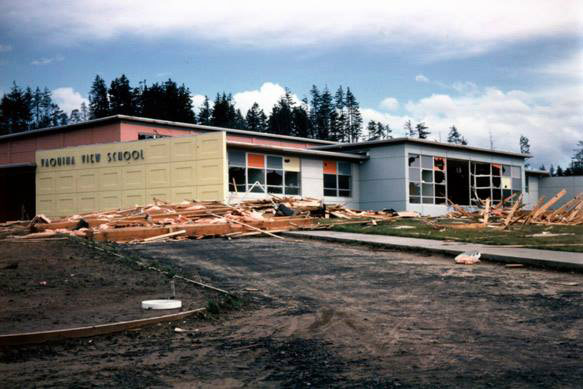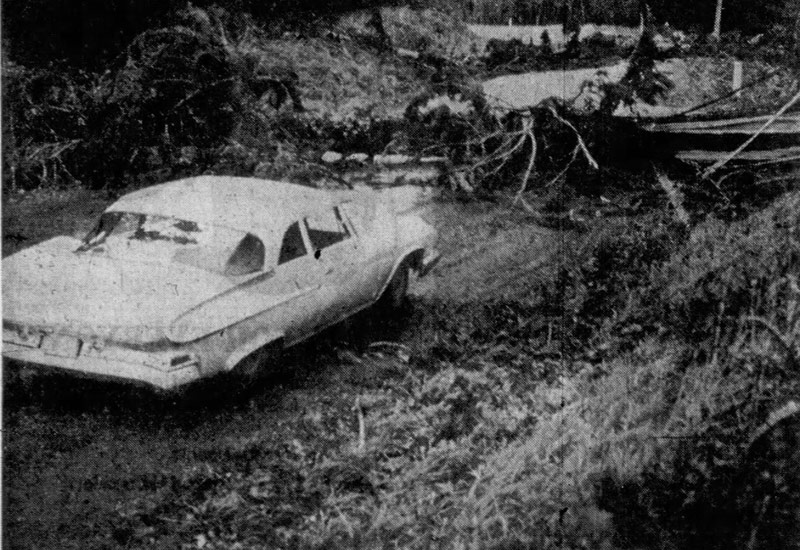Looking Back: Columbus Day Storm on Oregon Coast, 60 Years Ago Today
Published 10/12/22 at 10:04 PM
By Oregon Coast Beach Connection staff

Includes exclusive listings; some specials in winter
In Cannon Beach:
Includes rentals not listed anywhere else
In Manzanita, Wheeler, Rockaway Beach:
Some specials for winter
In Pacific City, Oceanside:
Some specials for winter
In Lincoln City:
Some specials for winter
In Depoe Bay, Gleneden Beach:
Some specials for winter
In Newport:
Look for some specials
In Waldport
Some specials for winter
In Yachats, Florence
Some specials for winter
Southern Oregon Coast Hotels / Lodgings
Reedsport to Brookings, places to stay; winter deals
(Oregon Coast) – October 12, 1962: what was at the moment still called Typhoon Freda made a crash landing in Oregon and SW Washington, as well as the Oregon coast, making its mark forever. Almost immediately those in the U.S. started calling it the Columbus Day Storm, and it's still the standard by which all subsequent storms have been measured. One serious tempest smacked the Oregon coast and the valley in the late 1990s with almost similar winds, but coming closer was the Great Coastal Gale of '07, which knocked out power along much of the north Oregon coast for days. (Photo above: a burning wigwam bites the dust in the storm at Bandon. Courtesy Bandon Historical Museum)
Oddly, the Oregon coast did not get quite the worst of the Columbus Day Storm. The highest of the wind gusts were at Mt. Hebo at 177 mph, while Portland's Morrison Bridge got hit with 116 mph. Over 40 people died throughout the western part of the state, but luckily only a handful on the coastline.
Inland, the infrastructure was less prepared, and many areas did not have power for weeks. With many more buildings than the coastline, the Willamette Valley suffered much higher losses in dollars. It's said that a building untouched by the storm was unusual.
Newport and the mouth of the Columbia River both recorded 120 mph gusts.
Damage along the Oregon coast was extensive and frightening, as often wind gusts stayed above hurricane levels in many areas, especially south. In Bandon, the high school was essentially destroyed with some 50 percent of the building gone.
In Gold Beach, a Mrs. Standage died from a falling tree. In Newport, on the following day, a body washed up, but it wasn't clear if that was from shipwreck a few days before or the storm.
Gold Beach was still reeling from a storm a couple of days before, which caused some $1 million in damage. 12 families were evacuated. Numerous buildings that weren't already damaged were now dented by this storm. Phone lines were down for days. Two sections of Pacific High School at Port Orford were wrecked.

Photo above copyright Oregon Coast Beach Connection
Cape Blanco recorded a gust of 145 just before the instrument was ripped apart in the Columbus Day Storm.
At Coos Bay, a 30-foot steel tower was toppled, which then proceeded to block the waterway. There, some 300 phone lines were knocked out. A calf was killed and another cow was injured so badly it had be put down. The Brunell Brothers dairy barn was toppled when the roof was torn off, causing one wall to give out and thus sending the others downward. The Brunell's sawmill down the river also had much of its roof torn off, while another timber company found almost all of its roof piled up elsewhere in town.

Photo courtesy Lincoln County Historical Society, Newport
Several residents in the Coos Bay area lost their roofs but the outdoor screen at the Bay Drive In theater still stood.
Reedsport, also on the south Oregon coast, had numerous businesses and homes damaged, including the grade school. Electric power was restored a day or so later, but many of the highways had to be cleared of trees.
Up in Florence, many roofs were torn off or severely damaged, and four light aircraft sustained battering damage at the local airport. In the bay, nearly 50 boats were wrecked in some way with some even being sunk. A tugboat wound up beached, and the famed Heceta Head Lighthouse was off for three hours.
In Newport, boats were also blown out of the water. Yaquina High School took quite a beating and was fairly wrecked.
Astoria saw a peak gust of 96 mph – not as big a deal these days. But plenty in the north Oregon coast town was smacked around, with telephone poles and timber lying everywhere. Main roads in and out of Clatsop County were blocked by trees.

Photo Capitol Journal: trees block the road at Highway 18
From the Lincoln City area comes an especially harrowing firsthand account (the town did not have that name yet, and was in fact several small burghs). Capitol Journal writer Gene Maudlin had been sent to the central coast to “look for a storm,” one which some meteorologists knew a little about beforehand. Hanging out at Oceanlake for awhile, nothing happened so he tried to venture back to Salem when he encountered the full force of it in the Van Duzer Corridor. He soon found the way home blocked and headed back to the coast.
There, in a bar in Oceanlake, he and many others huddled by candlelight to wait it out. Eventually, he thought he could make it back and was pleased to find a previous road block had been removed. Minutes later there was another, even larger tree in the way, and Maudlin along with some 300 others waited in their cars for that tree and yet another to be cut up.
In the six hours of waiting for roads to be cleared, he saw hardy, sturdy limber trucks with extensive damage, and a few cars left in the roadway after their occupants had given up and walked somewhere else.
[Sources: archives from Corvallis-Gazette Times, The World, Capitol Journal, Lincoln County Historical Society, Bandon Historical Society, Coos Bay History Museum)
Oregon Coast Hotels in this area - South Coast Hotels - Where to eat - Maps - Virtual Tours
Cannon Beach Lodging
Nehalem Bay Lodgings
Manzanita Hotels, Lodging
Three Capes Lodging
Pacific City Hotels, Lodging
Lincoln City Lodging
Depoe Bay Lodging
Newport Lodging
Waldport Lodging
Yachats Lodging
Oregon Coast Vacation Rentals
Oregon Coast Lodging Specials

Heceta Head early in the last century, courtesy Friends of Heceta Head Lighthouse
More About Oregon Coast hotels, lodging.....
More About Oregon Coast Restaurants, Dining.....
LATEST Related Oregon Coast Articles
A tour bus driver witnessed seven baby ducks fall into a sewer drain. Marine sciences
Lincoln City First on Oregon Coast to Ditch 4th of July Fireworks for Drone S...
A massive, dazzling drone show is in store for Independence Day. Lincoln City events
Upcoming S. Oregon Coast Events Include Gem Show, History: Coos Bay, Bandon
May 6 talk at Coos History Museum, Mayfly Fest May 17, Bandon Rock / Gem Show June 7,8
Killer Whale Sightings Making Big Splash on Oregon Coast - And It's the Apex ...
It's the same line of transient orcas involved in the whale kill in 2023. Marine sciences
Spring's Weird Things Along Washington, Oregon Coast
Whale burps, ocean burps, freaky skeletons, mermaid purses, live eggs, more. Marine sciences
Destructive, Invasive Crab Found on N. Oregon Coast, Officials Ask Public's Help
Chinese mitten crab was found near Astoria. Marine sciences
Oregon's Tillamook Coast Hosts Rigorous Kayaking, Hiking Events in May
Netarts events May 17 and 31; Manzanita events May 14
45 Years Ago Today: Explosion of Mt. Saint Helens Recorded from Oregon Coast
Hear the recording from Newport; some observations from being there. History
Back to Oregon Coast
Contact Advertise on Oregon Coast Beach Connection
All Content, unless otherwise attributed, copyright Oregon Coast Beach Connection. Unauthorized use or publication is not permitted



















































